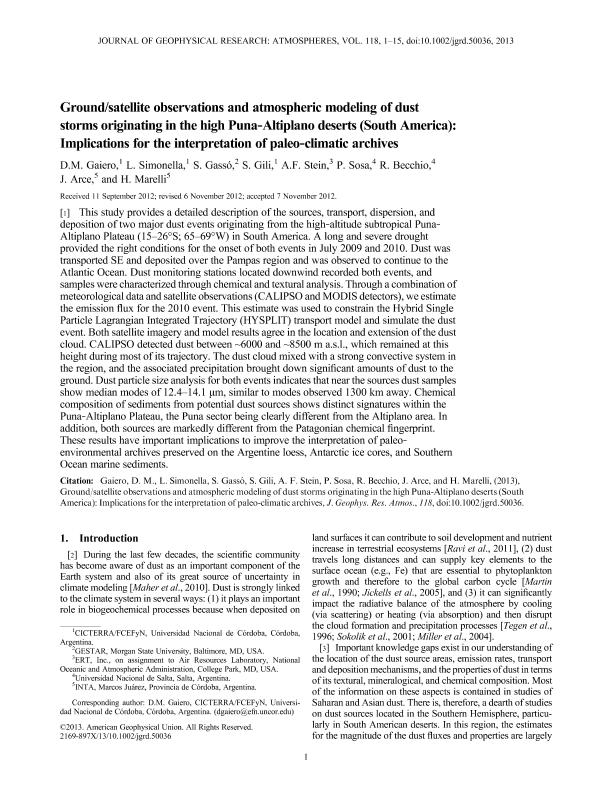Mostrar el registro sencillo del ítem
dc.contributor.author
Gaiero, Diego Marcelo

dc.contributor.author
Simonella, Lucio Esteban

dc.contributor.author
Gassó, S.
dc.contributor.author
Gili, Stefania

dc.contributor.author
Stein, A. F.
dc.contributor.author
Sosa, P.
dc.contributor.author
Becchio, Raul Alberto

dc.contributor.author
Arce, J.
dc.contributor.author
Marelli, H.
dc.date.available
2016-09-09T18:55:08Z
dc.date.issued
2013-05
dc.identifier.citation
Gaiero, Diego Marcelo; Simonella, Lucio Esteban; Gassó, S.; Gili, Stefania; Stein, A. F.; et al.; Ground/satellite observations and atmospheric modeling of dust storms originating in the high Puna‐Altiplano deserts (South America): Implications for the interpretation of paleo‐climatic archives; American Geophysical Union; Journal Of Geophysical Research; 118; 9; 5-2013; 3817-3831
dc.identifier.issn
0148-0227
dc.identifier.uri
http://hdl.handle.net/11336/7587
dc.description.abstract
This study provides a detailed description of the sources, transport, dispersion, and deposition of two major dust events originating from the high‐altitude subtropical Puna‐Altiplano Plateau (15?26°S; 65?69°W) in South America. A long and severe drought provided the right conditions for the onset of both events in July 2009 and 2010. Dust was transported SE and deposited over the Pampas region and was observed to continue to the Atlantic Ocean. Dust monitoring stations located downwind recorded both events, and samples were characterized through chemical and textural analysis. Through a combination of meteorological data and satellite observations (CALIPSO andMODIS detectors), we estimate the emission flux for the 2010 event. This estimate was used to constrain the Hybrid Single Particle Lagrangian Integrated Trajectory (HYSPLIT) transport model and simulate the dust event. Both satellite imagery and model results agree in the location and extension of the dust cloud. CALIPSO detected dust between ~6000 and ~8500 m a.s.l., which remained at this height during most of its trajectory. The dust cloud mixed with a strong convective system in the region, and the associated precipitation brought down significant amounts of dust to the ground. Dust particle size analysis for both events indicates that near the sources dust samples show median modes of 12.4?14.1 μm, similar to modes observed 1300 km away. Chemical composition of sediments from potential dust sources shows distinct signatures within the Puna‐Altiplano Plateau, the Puna sector being clearly different from the Altiplano area. In addition, both sources are markedly different from the Patagonian chemical fingerprint.These results have important implications to improve the interpretation of aleoenvironmental archives preserved on the Argentine loess, Antarctic ice cores, and Southern Ocean marine sediments.
dc.format
application/pdf
dc.language.iso
eng
dc.publisher
American Geophysical Union

dc.rights
info:eu-repo/semantics/openAccess
dc.rights.uri
https://creativecommons.org/licenses/by-nc-sa/2.5/ar/
dc.subject
Dust
dc.subject
Puna-Altiplano Deserts
dc.subject
Paleoclimate
dc.subject
Iron
dc.subject.classification
Geoquímica y Geofísica

dc.subject.classification
Ciencias de la Tierra y relacionadas con el Medio Ambiente

dc.subject.classification
CIENCIAS NATURALES Y EXACTAS

dc.title
Ground/satellite observations and atmospheric modeling of dust storms originating in the high Puna‐Altiplano deserts (South America): Implications for the interpretation of paleo‐climatic archives
dc.type
info:eu-repo/semantics/article
dc.type
info:ar-repo/semantics/artículo
dc.type
info:eu-repo/semantics/publishedVersion
dc.date.updated
2016-03-22T14:48:08Z
dc.journal.volume
118
dc.journal.number
9
dc.journal.pagination
3817-3831
dc.journal.pais
Estados Unidos

dc.journal.ciudad
Nueva York
dc.description.fil
Fil: Gaiero, Diego Marcelo. Consejo Nacional de Investigaciones Científicas y Técnicas. Centro Científico Tecnológico Córdoba. Centro de Investigaciones En Ciencias de la Tierra; Argentina
dc.description.fil
Fil: Simonella, Lucio Esteban. Consejo Nacional de Investigaciones Científicas y Técnicas. Centro Científico Tecnológico Córdoba. Centro de Investigaciones En Ciencias de la Tierra; Argentina
dc.description.fil
Fil: Gassó, S.. Morgan State University; Estados Unidos
dc.description.fil
Fil: Gili, Stefania. Consejo Nacional de Investigaciones Científicas y Técnicas. Centro Científico Tecnológico Córdoba. Centro de Investigaciones en Ciencias de la Tierra; Argentina
dc.description.fil
Fil: Stein, A. F.. National Oceanic and Atmospheric Administration; Estados Unidos
dc.description.fil
Fil: Sosa, P.. Universidad Nacional de Salta. Consejo de Investigacion; Argentina
dc.description.fil
Fil: Becchio, Raul Alberto. Universidad Nacional de Salta; Argentina
dc.description.fil
Fil: Arce, J.. Instituto Nacional de Tecnología Agropecuaria. Centro Regional Córdoba. Estación Experimental Agropecuario Marcos Juarez; Argentina
dc.description.fil
Fil: Marelli, H.. Instituto Nacional de Tecnología Agropecuaria. Centro Regional Córdoba. Estación Experimental Agropecuario Marcos Juarez; Argentina
dc.journal.title
Journal Of Geophysical Research

dc.relation.alternativeid
info:eu-repo/semantics/altIdentifier/url/http://onlinelibrary.wiley.com/doi/10.1002/jgrd.50036/abstract
dc.relation.alternativeid
info:eu-repo/semantics/altIdentifier/doi/http://dx.doi.org/10.1002/jgrd.50036
Archivos asociados
